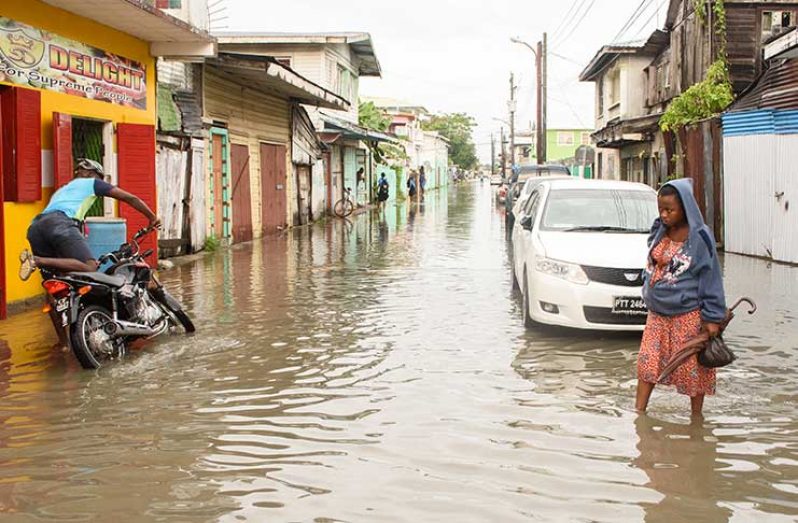Is the work of the 2015 clean-up campaign being undone?
by Francis Quamina Farrier
“THE rain doing its work, but we not doing ours, and that is why we still getting flood.” That was the opinion of an elder citizen who was sharing her thoughts with regard to the continued flooding of a few sections of the city of Georgetown, after rain-fall. She is from the generation of those now depleting senior citizens who lived in our capital city, back in the days when it was known as ‘The Garden City of the Caribbean’, and when wooden vats and not large plastic containers were used to store potable water. The vats in the yards are all gone, but for our citizens 70 years and older, the memories of a cleaner capital city will always remain with them.
The reality is that many older citizens of Georgetown are wondering why sections of the city still floods, sometimes after just a little rain-fall. They have been longing for the return to the era when Georgetown had many more canals which contained rain fall water, which averted any flooding. Those elders also know of the era when all canals and drains in the city were always kept clean and tidy. After over three decades of a very filthy Georgetown, many elders refer to the massive ‘Clean-Up’ campaign which was carried out during the latter half of 2015, and are extremely pleased with the experience of the vast improvement which the city and citizens enjoyed during the following months. Unfortunately, they have come to the realisation that their situation is not exactly out of the woods.
Some areas of the city still experience flooding after the showers, and many citizens are affected.
Yes, sections of Georgetown are still bedevilled with floods after rainfall, and that is of concern by the affected citizens. There are areas of the city where students and adults can be seen wading through flooded streets. Even though not quite as terrible as the pre-2015 era, when many streets in Georgetown were transformed into canals after a shower, causing many citizens to lose thousands and even millions of dollars’ worth of property, there still remain areas of Georgetown which continue to experience flooding.

Clean-up Campaign
During the pre-2015 clean-up of Georgetown, there were also lots of physical inconvenience, due to the regular mass flooding during and after the rains, and that seemed to be more regular than in the 20th century, when there were the traditional two Rainy Seasons, which were orderly and predictable.
There is a growing number of (younger) Guyanese who have never experienced the past times when there were just two rainy seasons in this country; the big May-June rains and the December pre-Christmas rains. Most of the older folks, (the 70 plus age group), would also reminisce about what it was like to be able to plan outdoor activities with no need for a plan B, just in case it rains.
During the just ended first half of 2017, there have been lots and lots of rain fall, and many citizens in the affected areas are expressing a measure of disappointment and frustration at the on-going floods. Most citizens are of the view that the floods are unnecessary for the better part, and point out the need for another massive clean-up of major and minor arteries of the city’s drainage system. Some older citizens have recommended that prison labour should be deployed on a regular basis to help, “Keep the city clean”, as was done during the colonial era. That, of course, is frowned on in this day and age. “Prisoners have rights”, as some Human Rights advocates would say.
Indeed, prison labour is somewhat controversial with voices raised against what is regarded as a retrograde step; in colonial times, prison labour was part of the “Keep the city clean” strategy. The fact of the matter is, clean-up campaigns would become unnecessary if we return to the culture of daily clean-ups. Or better still, a culture of not littering or dumping garbage indiscriminately, especially in the city’s water-ways. Regular and proper garbage disposal is also part of the solution.
Continued flooding
So why does Georgetown still suffer from floods after what many citizens regard as a great clean-up operation during the final months of 2015? Most of us know the likely reasons. After the massive clean-up campaign of 2015, many citizens, myself included, rightly congratulated City Hall and the Ministry of Public Infrastructure for a job well done. Georgetown was reformed from being the “Garbage City” of the past 40 or more years, to a much improved and impressive environment. There was change of a positive nature. The post clean-up rains came and there was no flooding as was previously experienced over the past decades. Concrete drains which had not seen the light of day for almost half a century, were once more gazing at the sunlight. Our capital city was returning to its previous title of being “The Garden City of the Caribbean”.
Where for decades previously there were hills and mountains of litter and garbage almost everywhere, flowers began to bloom again, for example, along the southern end of East Street in South Cummingsburg. That particular undertaking was done by businessman, Mr Rahaman, who operates a fruit selling outlet from a truck at that location. For many months after that historic clean-up of Georgetown, garbage and litter were hardly seen anywhere in most areas of the city. Unfortunately, in more recent months, things seem to be returning to the garbage era. There are pockets of litter and garbage creeping back into some locations, including around the Parliament Building.
During an exclusive meeting hosted by the Speaker of Parliament, Hon. Dr. Bartland Scotland some months ago, a promise was made to have the pavements around the Public Buildings kept clean and tidy. The north to south drain at the western side of the Public Buildings, is filthy and disgusting once again. A few vagrants continue to make the Brickdam and Cornhill Street pavements around the Public Buildings their home, with the resulting litter and filth along those special pedestrian walk-ways.
While there are many attractive litter bins placed in quite a number of areas around the city, especially in the downtown business district, complements of the City Council and some corporate citizens, more obviously needs to be done to have the city of Georgetown looking better than it ever was in its almost two century history. Kudos and commendations must be given to such Corporate Citizens as Action Tyre, COURTS, John Fernandes Limited, Mings Products & Services and others, for their support in the efforts to keep the city clean.
Some of those recently deployed litter bins are very colourful and attractive, and one has to agree that Georgetown, while struggling to regain its beauty, is succeeding to some measure, to keep a pretty face. The recent make-over was of a positive nature. Over the past year, many city streets have been resurfaced. Good for the City Council and more so, the Ministry of Public Infrastructure in particular. They did merit praise immediately after that initial clean-up campaign and the on-going resurfacing of so many previously pot-hole riddled streets. Bravo to Minister of Public Infrastructure, David Patterson, for a job well-done.
Remaining problems
However, one of the disappointments for many citizens is the horrible condition of the two blocks of Bourda Street between North Road and Regent Street. It is a set-back which I have addressed in a previous feature. Some elders keep falling and injuring themselves as they try to navigate the many pot holes on Bourda Street. In the developed world, the City Council would have been in receipt of many costly lawsuits submitted by the lawyers of injured elders and others. The drains around the Bourda Market, are also very filthy and in need of better cleaning. The City Council has been lobbied to collaborate with the Ministry of Public Infrastructure to get those two blocks of Bourda Street resurfaced. That has so far not happened.
Hundreds of citizens traverse those two blocks of Bourda Street every week, and are verily inconvenienced because of its horrible condition. The Ministry of Public Infrastructure says that it is ready to get the job done. It is now up to the City Council and the vendors to cooperate with the Ministry; City Council needs to relocate the vendors for a few days to allow the resurfacing work to be done, and the drains properly cleaned. The vendors need to cooperate with City Council and sacrifice a few days full earning, by going to another location identified by City Hall. The City Council, of course, will need to identify a suitable location, and Mayor Patricia Chase-Green indicated that she has already identified such a location near to the market. It is time to get the action going to improve Bourda Street for the thousands who traverse it every month.
Kokers and Canals
For years now, I have been checking regularly on the koker out-falls in the city of Georgetown and at other locations. Most are reasonably silt-free now. However, we are not totally out of the woods, since some of those koker out-falls could do with some more attention at this time. So too, some of the principal canals in the city need work; the Church Street Canal and the Avenue of the Republic canal, being two prime examples. More recently, in many sections of the Avenue of the Republic canal, silt can be seen rising almost to the very surface. Nothing was done during the dry season earlier this year. It is certainly time for another desilting exercise to be done to that important section of the drainage system of Georgetown, as soon as possible.
I have been noticing that the area of the city bounded by the Avenue of the Republic at the east, Water Street at the west, Home Street at the north and Croal street at the south, seem to be flooded even when the water level of the Avenue of the Republic canal is much lower. Although not an expert, one can assume that there are blockages from the drains to those principal canals, and that attention should be given to clear those blockages, no doubt within the culverts.
A magnificent predicament for a Government Minister
Minister of Public Infrastructure, David Patterson, has been attracting quite a lot of positive buzz about how much work his ministry has achieved since his appointment. His success has, in a way, also brought him some negative buzz.
There is the story of the great Italian American tenor, Enrico Caruso, 1873-1921 – who was seen trembling backstage just before making his entrance to sing to an adoring audience. On noticing his discomfort, the stage manager asked him what was wrong, to which Caruso responded, “The audience”. The Stage Manager was very puzzled and cheered up the singer saying, “Enrico, the audience loves you”, to which Caruso responded, “Yes, I know they love me. “From other singers they want 100 percent, but from Caruso, they want a 120 percent.” What a predicament!
And so, that is exactly the predicament faced by Minister David Patterson; many citizens want a 120 percent from him, based on how much work his ministry has successfully done and he has already achieved, and in so short a time. What a magnificent predicament for that young minister of Government to be faced with!




.png)









